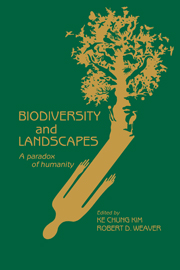Book contents
- Frontmatter
- Contents
- Contributors
- Preface
- Part I Introduction
- Part II Human values and biodiversity
- Part III Human processes and biodiversity
- Part IV Management of biodiversity and landscapes
- Part V Socioeconomics of biodiversity
- Part VI Strategies for biodiversity conservation
- 16 Market-based economic development and biodiversity: an assessment of conflict
- 17 Technology and biodiversity conservation: are they incompatible?
- 18 “Emergy” evaluation of biodiversity for ecological engineering
- 19 Urban horticulture: a part of the biodiversity picture
- 20 The watchdog role of nongovernmental environmental organizations
- 21 Legislative and public agency initiatives in ecosystem and biodiversity conservation
- Part VII Biodiversity and landscapes: postscript
- Index
17 - Technology and biodiversity conservation: are they incompatible?
Published online by Cambridge University Press: 04 August 2010
- Frontmatter
- Contents
- Contributors
- Preface
- Part I Introduction
- Part II Human values and biodiversity
- Part III Human processes and biodiversity
- Part IV Management of biodiversity and landscapes
- Part V Socioeconomics of biodiversity
- Part VI Strategies for biodiversity conservation
- 16 Market-based economic development and biodiversity: an assessment of conflict
- 17 Technology and biodiversity conservation: are they incompatible?
- 18 “Emergy” evaluation of biodiversity for ecological engineering
- 19 Urban horticulture: a part of the biodiversity picture
- 20 The watchdog role of nongovernmental environmental organizations
- 21 Legislative and public agency initiatives in ecosystem and biodiversity conservation
- Part VII Biodiversity and landscapes: postscript
- Index
Summary
Introduction
The major question considered in this chapter is whether we can develop a civilization that allows wildness to persist. By this I do not mean the wildness that sends big city teenagers on a rampage mutilating and sometimes murdering innocent persons nearby. I am using wildness in the sense that Thoreau used it; a natural system unadjusted by nature trails, parking lots, and concession stands to satisfy the needs of human society. Environmentalists have often been accused of not being open to compromise that is so characteristic of reasonable people. Unfortunately, all the major environmental compromises possible have been made. These have resulted in less than 3% of the globe's land mass remaining in what Thoreau would have accepted in his most charitable mood as wildness. A world that runs itself is fading from memory. In its place is a “managed” environment supervised by governments that cannot balance budgets. If technology and biodiversity are to coexist, it must be a technology that wildness can endure. Ecologists perpetually talk about the interdependence of things and lip service is given to this notion on Earth Day, but, in practice, we approach environmental problems one fragment at a time, not as a complex, multivariate, interdependent landscape. The coexistence of technology and biodiversity depends on switching from a fragmented to a landscape view.
- Type
- Chapter
- Information
- Biodiversity and LandscapesA Paradox of Humanity, pp. 327 - 338Publisher: Cambridge University PressPrint publication year: 1994

